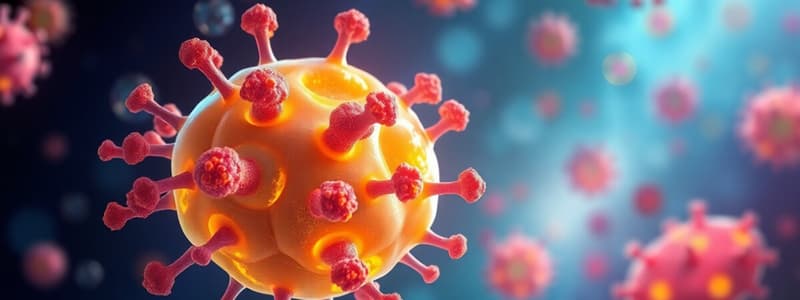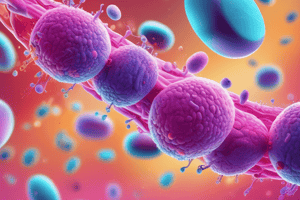Podcast
Questions and Answers
What is the primary purpose of an antibiotic susceptibility test?
What is the primary purpose of an antibiotic susceptibility test?
- To measure the concentration of antibiotics in a patient's bloodstream.
- To determine the effectiveness of different antibiotics against a specific pathogen. (correct)
- To identify the genetic mutations conferring antibiotic resistance.
- To analyze the spectrum of activity for novel antimicrobial agents.
Selective toxicity, a key principle in antimicrobial drug development, aims to:
Selective toxicity, a key principle in antimicrobial drug development, aims to:
- Inhibit the growth of all microorganisms, regardless of their location.
- Harm the host cells while eradicating the pathogenic microbes.
- Target the pathogen without causing significant harm to the host cells. (correct)
- Target any rapidly dividing cell, including both pathogens and host cells.
What distinguishes a narrow-spectrum antimicrobial from a broad-spectrum antimicrobial?
What distinguishes a narrow-spectrum antimicrobial from a broad-spectrum antimicrobial?
- Narrow-spectrum antimicrobials target specific types of bacteria, while broad-spectrum antimicrobials are effective against a wide range of bacteria. (correct)
- Narrow-spectrum antimicrobials can only be administered intravenously, while broad-spectrum antimicrobials can be taken orally.
- Narrow-spectrum antimicrobials have a higher toxicity level compared to broad-spectrum antimicrobials.
- Narrow-spectrum antimicrobials are effective against a wide range of bacteria, while broad-spectrum antimicrobials target specific bacteria.
Which of the following is NOT a primary cellular target of antibiotics?
Which of the following is NOT a primary cellular target of antibiotics?
How do bactericidal antibiotics differ from bacteriostatic antibiotics?
How do bactericidal antibiotics differ from bacteriostatic antibiotics?
Which mechanism is LEAST likely to be used by bacteria to resist the effects of antibiotics?
Which mechanism is LEAST likely to be used by bacteria to resist the effects of antibiotics?
Antibiotic resistance can be acquired through mutations or by:
Antibiotic resistance can be acquired through mutations or by:
What is the key principle behind the Kirby-Bauer test in determining antibiotic susceptibility?
What is the key principle behind the Kirby-Bauer test in determining antibiotic susceptibility?
In the E-test, what does the Minimum Inhibitory Concentration (MIC) represent?
In the E-test, what does the Minimum Inhibitory Concentration (MIC) represent?
In the Kirby-Bauer method, which standard is used to adjust the bacterial suspension?
In the Kirby-Bauer method, which standard is used to adjust the bacterial suspension?
During the Kirby-Bauer test, what is the purpose of using a control disk?
During the Kirby-Bauer test, what is the purpose of using a control disk?
What does the term 'antiseptic' refer to in the context of antimicrobial agents?
What does the term 'antiseptic' refer to in the context of antimicrobial agents?
Which factor does NOT typically influence the effectiveness of antimicrobial chemical agents?
Which factor does NOT typically influence the effectiveness of antimicrobial chemical agents?
Why might the presence of organic materials like blood or saliva reduce the effectiveness of a disinfectant?
Why might the presence of organic materials like blood or saliva reduce the effectiveness of a disinfectant?
Bleach is an example of a:
Bleach is an example of a:
Which of the following is a common mode of action for antiseptics like Betadine?
Which of the following is a common mode of action for antiseptics like Betadine?
If a bacterial species is determined to be 'intermediate' in its susceptibility to an antibiotic in a Kirby-Bauer test, what does this result typically suggest?
If a bacterial species is determined to be 'intermediate' in its susceptibility to an antibiotic in a Kirby-Bauer test, what does this result typically suggest?
A bacterium displays a zone of inhibition of 10 mm around a gentamicin disk (10 μg) in a Kirby-Bauer assay. According to the reference table, isolates with zones ≤ 12 mm are resistant. What can be concluded?
A bacterium displays a zone of inhibition of 10 mm around a gentamicin disk (10 μg) in a Kirby-Bauer assay. According to the reference table, isolates with zones ≤ 12 mm are resistant. What can be concluded?
Why is it important to incubate the plates in an inverted position in the Kirby-Bauer method?
Why is it important to incubate the plates in an inverted position in the Kirby-Bauer method?
Which of the following statements best describes the concept of 'selective toxicity' in antimicrobial therapy?
Which of the following statements best describes the concept of 'selective toxicity' in antimicrobial therapy?
Which of the following mechanisms enables bacteria to develop resistance to beta-lactam antibiotics like penicillin?
Which of the following mechanisms enables bacteria to develop resistance to beta-lactam antibiotics like penicillin?
Which step is essential when preparing a bacterial lawn for antibiotic susceptibility testing to ensure accurate results?
Which step is essential when preparing a bacterial lawn for antibiotic susceptibility testing to ensure accurate results?
How does the E-test differ from the Kirby-Bauer disk diffusion method in determining antibiotic susceptibility?
How does the E-test differ from the Kirby-Bauer disk diffusion method in determining antibiotic susceptibility?
In the disk-diffusion method, what does a larger zone of inhibition generally indicate?
In the disk-diffusion method, what does a larger zone of inhibition generally indicate?
What is the primary difference between a disinfectant and a sterilant?
What is the primary difference between a disinfectant and a sterilant?
Which of the following factors affects the activity of disinfectants?
Which of the following factors affects the activity of disinfectants?
Ethanol is an effective:
Ethanol is an effective:
Which statement accurately describes how antimicrobial susceptibility tests help inform treatment choices for infectious diseases?
Which statement accurately describes how antimicrobial susceptibility tests help inform treatment choices for infectious diseases?
What is the role of the 'control disk' in an antimicrobial disk diffusion assay?
What is the role of the 'control disk' in an antimicrobial disk diffusion assay?
Following incubation of a disk diffusion test, several colonies are observed growing within the zone of inhibition. What is the most likely explanation for this observation?
Following incubation of a disk diffusion test, several colonies are observed growing within the zone of inhibition. What is the most likely explanation for this observation?
What is an iodophor?
What is an iodophor?
Hydrogen peroxide is effective as:
Hydrogen peroxide is effective as:
What is the significance of emerging antibiotic resistance in healthcare?
What is the significance of emerging antibiotic resistance in healthcare?
In antibiotic susceptibility testing, what does the term 'resistance' mean?
In antibiotic susceptibility testing, what does the term 'resistance' mean?
Why is it necessary to use sterile swabs and equipment in the Kirby-Bauer method?
Why is it necessary to use sterile swabs and equipment in the Kirby-Bauer method?
Flashcards
What is an antibiotic?
What is an antibiotic?
A substance produced by microbes, inhibiting other microorganism growth.
What is selective toxicity?
What is selective toxicity?
The ability of an antimicrobial to harm the pathogen without harming the host cells.
What is the spectrum of action?
What is the spectrum of action?
The range of bacteria an antimicrobial is effective against.
What are bacterial cellular targets?
What are bacterial cellular targets?
Signup and view all the flashcards
What does bacteriostatic mean?
What does bacteriostatic mean?
Signup and view all the flashcards
What does bactericidal mean?
What does bactericidal mean?
Signup and view all the flashcards
What are the 4 main mechanisms of resistance?
What are the 4 main mechanisms of resistance?
Signup and view all the flashcards
What are examples of emerging resistance?
What are examples of emerging resistance?
Signup and view all the flashcards
What is the antibiotic susceptibility test?
What is the antibiotic susceptibility test?
Signup and view all the flashcards
Name common antimicrobial susceptibility tests
Name common antimicrobial susceptibility tests
Signup and view all the flashcards
What is the Kirby-Bauer test?
What is the Kirby-Bauer test?
Signup and view all the flashcards
How are microbes classified in the Kirby-Bauer test?
How are microbes classified in the Kirby-Bauer test?
Signup and view all the flashcards
What is the E-test?
What is the E-test?
Signup and view all the flashcards
What is minimum inhibitory concentration (MIC)?
What is minimum inhibitory concentration (MIC)?
Signup and view all the flashcards
What materials are used in Kirby-Bauer method?
What materials are used in Kirby-Bauer method?
Signup and view all the flashcards
What is the Kirby-Bauer method?
What is the Kirby-Bauer method?
Signup and view all the flashcards
How are antibiotic discs placed?
How are antibiotic discs placed?
Signup and view all the flashcards
How is data measured and indicated?
How is data measured and indicated?
Signup and view all the flashcards
What are disinfectants?
What are disinfectants?
Signup and view all the flashcards
What are antiseptics?
What are antiseptics?
Signup and view all the flashcards
What is "-static" or "-cidal" activity?
What is "-static" or "-cidal" activity?
Signup and view all the flashcards
What factors affects effectiveness of antimicrobials?
What factors affects effectiveness of antimicrobials?
Signup and view all the flashcards
How does accessibility affect antimicrobial effectiveness?
How does accessibility affect antimicrobial effectiveness?
Signup and view all the flashcards
Give some examples of disinfectants/antiseptics
Give some examples of disinfectants/antiseptics
Signup and view all the flashcards
How is a bacterial lawn prepared?
How is a bacterial lawn prepared?
Signup and view all the flashcards
What indicates antimicrobial effectiveness?
What indicates antimicrobial effectiveness?
Signup and view all the flashcards
Study Notes
- This laboratory session covers antibiotic susceptibility testing, resistance, and antimicrobial chemicals as disinfectants/antiseptics
Antibiotic Susceptibility Test
- Determines the effectiveness of antibiotics against specific bacteria
- Involves selective toxicity, spectrum of activity, and bacterial cellular targets
- Can determine the bacteriostatic/bactericidal effect of antibiotics
- Used to identify resistance to antibiotics and study selected cases of emerging resistance
- Includes methods like the Kirby-Bauer test
- Selective Toxicity*
- A key aspect of antibiotics where antimicrobials target pathogens, not host cells
- Spectrum of Action*
- Can be narrow (effective against a limited range of bacteria) or broad (effective against a wide range of bacteria)
- Cellular Targets*
- Antibiotics can target the cell wall, protein synthesis, nucleic acid replication/transcription, the plasma membrane, or essential metabolite synthesis
Antibiotics
- Antibiotics are antimicrobial drugs used for patient therapy
- Are substances produced by certain microbes
- In small amounts, they inhibit the growth of other microorganisms
- Bactericidal Antibiotics*
- Kill target bacterial cells through various mechanisms depending on the antibiotic
- Beta-lactam drugs (e.g., penicillin) and bacitracin/vancomycin interfere with cell wall synthesis, killing bacterial cells
- Bacteriostatic Antibiotics*
- Inhibit the growth of target microbes
- Do not kill bacteria directly; the host's immune system eliminates them
- Tetracycline interferes with protein synthesis
- Sulfadrugs inhibit folic acid synthesis
Mechanisms of Resistance Against Antibiotics
- Resistance can be acquired through mutations or genetic exchange, such as R plasmids
- Emerging Resistance Examples*
- MRSA
- VRSA
- VRE
- MDR-TB
- ESBLS
Antimicrobial Susceptibility Tests
- Used to determine the most effective antibiotic against a given pathogen
- Includes the Kirby-Bauer method, E-test, and broth dilution method
- Kirby-Bauer Test*
- A disc-diffusion method for measuring of antibiotic effectiveness
- Compares the effectiveness of different antibiotics by measuring the zones of inhibition
- Organisms are classified as susceptible, intermediate, or resistant based on zone size
- E-Test*
- An advanced diffusion method used to calculate the Minimum Inhibitory Concentration (MIC)
- The MIC is the minimum amount of drug needed to inhibit the growth of the bacterial species or strain
- Plastic-coated strips contain an increasing concentration gradient of the antibiotic
- The MIC can be read from a scale printed on each strip
- The Minimum Bactericidal Concentration (MBC) of a drug, which kills the the target microbe in vitro, can be calculated using broth dilution
Kirby Bauer Method
- Involves the use of standard conditions
- Assesses data by measuring the inhibition zones and using reference tables
- Uses 0. 5 McFarland turbidity standard to determine the cell concentration of the broth culture for the test
- Materials Typically Used*
- Bunsen burner
- Penicillin
- Sterile swab
- Mueller-Hinton plates or TSA plates
- McFarland and sterile saline standards
- Sterile paper disks
- Tweezers/ethyl alcohol
- Incubator
- Procedure*
- Prepare a bacterial lawn on the Mueller Hinton plate and place antibiotic discs on the seeded plate
- Incubate plates in an inverted position (18-24h, 35°C)
- After incubation, record growth, presence/absence of inhibition zones, and measure the diameter of inhibition zones to assess the data against reference tables
Analysis of Results with the Kirby Bauer Method
- Growth on a control disk indicates positive growth around the disk with no antibiotics
- No inhibition zone around a disk indicates resistance
- A zone with inhibition may or may not mean susceptibility
- Measure the zone diameter and compare to a zone diameter on a reference chart to determine if an organism is susceptible, intermediate, or resistant
Antimicrobial Chemical Agents
- Can be disinfectants or antiseptics
- Disinfectants*
- Chemical agents that kill microbes, including pathogens, on inanimate objects or surfaces
- Antiseptics*
- Chemical agents that kill microbes, including pathogens, on skin or other tissue
- "-Static" vs. "-cidal"*
- "-Static" agents inhibit growth
- "-Cidal" agents kill the target microbe
Factors Affecting Effectiveness
- Effectiveness is affected by the numbers and types of microbes present and accessibility to the target microbes
- Other factors include the concentration of agent, the temperature, and the pH
- Organic materials (blood, saliva, vomit, or fecal matter) can interfere with the accessibility of antimicrobial chemicals in health care facilities
Common Antimicrobial Chemicals
- Bleach (0. 5% and 5%): sodium hypochlorite or calcium hypochlorite, chlorine, halogen
- Ethanol (70% and absolute): alcohol
- Lysol: contains benzalkonium chloride, hydrogen peroxide, ethyl alcohol, or phenol-based compounds
- Listerine: essential oils like menthol or thymol
- Betadine: iodophor, iodine, halogen
- Hydrogen Peroxide: oxidizing agent
Studying That Suits You
Use AI to generate personalized quizzes and flashcards to suit your learning preferences.



